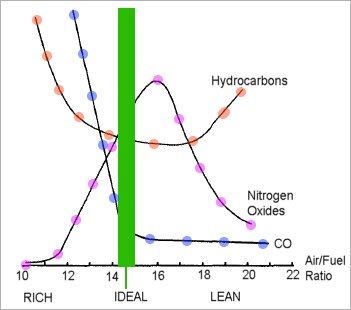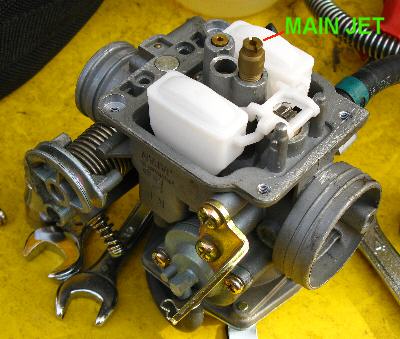Scooter Carburetor Re-jetting
To obtain maximum performance of your scooter, the carburetor must supply the correct fuel/air mixture all the way though the full range of throttle openings. The carburetor determines the fuel/air ratio, though the air filter and exhaust have some effect too. If the air filter is restrictive for example, it can lower the amount of air being supplied when the throttle is wide open and so make the mixture leaner than it should be.
What controls how well the scooter runs when the throttle is most of the way open is the carburetor main jet. This is basically a hole, and the bigger the hole, the more fuel can flow. How big the main jet need to be depends on the size of the carburetor and how much air is flowing. Since the air is less dense at high elevations and at high temperatures, you may need a smaller hole (less fuel) at 95 degrees in the high dessert than you do at sea level and freezing temperatures.
Manufacturers tend to use the smallest possible main jet for two reasons. First, you get slighly better mileage. Second, exhaust emissions (CO and HC[hydrocarbons]) are lower if the engine runs slightly lean (less fuel in the fuel/air mixture) than slightly rich (more fuel in the fuel/air mixture). Nitrogen Oxide (NOX) exhaust emissions are higher if the mixture is lean though, so it's a tricky balance.
Since scooters don't usually have catalytic converters like cars do, running the engine lean is one way to keep CO and HC exhuast emissions under control. However if you go too lean, the engine may overheat, power will drop and emissions will go up. If you go too rich the scooter will splutter and performance will drop and emissions will increase. Manufacturers don't know what temperature you'll be riding in or what elevation you'll be riding at and so to stay on the lean side, they often use a jet smaller than the optimimum size for performance, just to make sure that wherever you are, the engine will be running on the lean side at full throttle rather than the rich side. The ideal condition is to have the correct air/fuel ratio at low speeds, not to run lean or rich, and under that condition emissions will still be well controlled and the engine will give good performance. However at high speeds and under hard acceleration it's best to run a slightly richer mixture in order to keep temperatures down and prevent pre-detonation ("knocking" or "pinging"). Maximum power is usually developed when the mixture is slightly rich.
Nitrogen Oxide (NOX) exhaust emissions are higher if the mixture is lean though, so it's a tricky balance.
Since scooters don't usually have catalytic converters like cars do, running the engine lean is one way to keep CO and HC exhuast emissions under control. However if you go too lean, the engine may overheat, power will drop and emissions will go up. If you go too rich the scooter will splutter and performance will drop and emissions will increase. Manufacturers don't know what temperature you'll be riding in or what elevation you'll be riding at and so to stay on the lean side, they often use a jet smaller than the optimimum size for performance, just to make sure that wherever you are, the engine will be running on the lean side at full throttle rather than the rich side. The ideal condition is to have the correct air/fuel ratio at low speeds, not to run lean or rich, and under that condition emissions will still be well controlled and the engine will give good performance. However at high speeds and under hard acceleration it's best to run a slightly richer mixture in order to keep temperatures down and prevent pre-detonation ("knocking" or "pinging"). Maximum power is usually developed when the mixture is slightly rich.
When at full throttle my scooter would sometimes hesitate and even speed up slightly when I backed off from fully open. These are hints that the engine may be a little fuel starved at wide throttle openings, suggesting the main jet may be a little small and the mixture too lean. I wondered just how small my main jet was so I took my carburetor apart and removed the main jet. It was a "107", which means the diameter of the hole in it was 1.07mm. I decided to increase the size slightly and see if the scooter performance improved, so I replaced it with a "115" jet (1.15mm diameter). The difference was significant. The scooter accelerates faster, pulls better up hills and is more responsive to the throttle. Not bad for a $6 upgrade!
The process for changing the main jet size is pretty simple. First remove the carburetor. To do this you'll probably need to take some parts off the scooter, such as the underseat storage container and possibly some body panels. Every scooter will be different. Disconnect the fuel line and vacuum lines, disconnect the auto enricher (choke), disconnect the throttle cable, disconnect the air intake hose and disconnect the inlet manifold. At this point you should (with a little luck), be able to wiggle the carburetor out of the scooter.
At the bottom of most carburetors you'll find the float chamber, usually secured to the carburetor body by four screws. Remove these screws and the float chamber should separate from the body. If you haven't drained it, it will be full of gas, so be careful. It should now look something like the image below:

On most carburetors, the main jet is the one which sticks out as shown above.  The jet itself is actually just the top part of the brass tube which sticks up out of the aluminum carburetor body (see the picture of the main jet over on the left). The lower part is the atomizer and it can stay in the carburetor body. Only the main jet need to be changed. Be sure to use the right sized screwdriver to remove it. Brass is quite soft and you don't want to damage the screw slot. So unscrew the main jet (you might need a wrench on the atomizer tube) and replace it with the new one. Screw it in tight, but you don't need to use a lot of force. Just make sure it's not loose. That's it. You've now replaced the main jet in your carburetor!
The jet itself is actually just the top part of the brass tube which sticks up out of the aluminum carburetor body (see the picture of the main jet over on the left). The lower part is the atomizer and it can stay in the carburetor body. Only the main jet need to be changed. Be sure to use the right sized screwdriver to remove it. Brass is quite soft and you don't want to damage the screw slot. So unscrew the main jet (you might need a wrench on the atomizer tube) and replace it with the new one. Screw it in tight, but you don't need to use a lot of force. Just make sure it's not loose. That's it. You've now replaced the main jet in your carburetor!
Now put it all back together! Mount the carburetor back in the scooter. Make sure the hoses are secure on the air inlet in intake manifold sides of the carburetor. You don't want any air leaks. Then reconnect the throttle cable, fuel line and vacuum hoses. Finally plug the auto enricher back in. At this point you should be done, but check around to make sure you really have reconnected all the vacuum hoses properly of the scooter won't run well. You may have to crank the scooter over a few times since the carburetor has to fill with gas before it will start. If all is well, it will start up and idle well. Changing the main jet should have absolutely no effect on the idle, so if the engine stalls or won't start, it's not the main jet that's the problem. You've probably forgotten to connect something up, or you've connected the wrong hose to the wrong place or you've accidentally disturbed the idle speed adjustment screw.
Assuming the scooter starts, take it for a spin. If the scooter runs better, you made a good choice for the new main jet. If it doesn't, then you picked the wrong size and you may need to try again. Most carbs on 150cc scooters have main jets from the factory of about 1.07 or 1.08mm (#107 or #108). If you fit a high flow air filer and performance exhaust you may need to go up as high as 1.3mm (#130). If you stick with the standard air filter and exhaust (like I did), maybe a #115 will give you better running, but #120 or #130 main jets would be likely to deliver a mixture that was too rich. I'm just about at sea level and winter is coming, so the air is cold (and denser). For me going from #107 to #115 made a significant difference, but for you it may not. However for around $6 and less than an hour's work, it's worth a try.
I bought my new main jet from eBay - see . Most of the carburetors used on chinese scooters use the same sized main jet body (i.e. the threads on the jet are the same. Smaller engine sizes use smaller holes in the jet of course). If you've found this article useful, please bookmark it via one of the services listed below it or link to it so that others can find it.
Digg this | Post to del.icio.us | Post to Furl